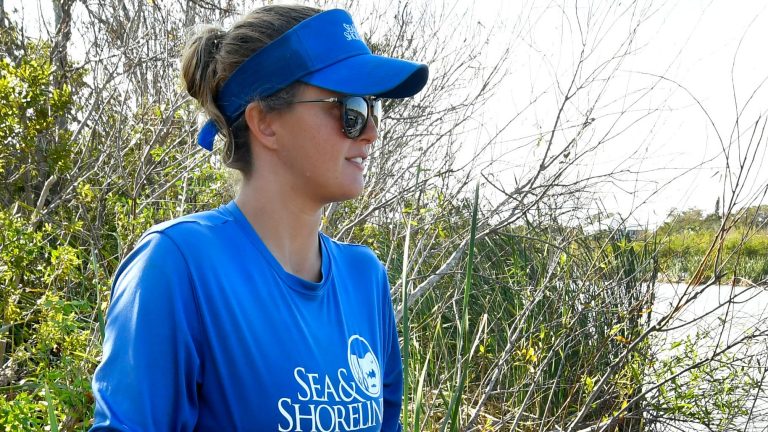
The grass is seldom greener these days on the underside of the Indian River Lagoon. For the past decade, the waterway has become a graveyard for seagrass: the place where it just dies.
Rhizomes, or the seagrass roots that enable it to spread and grow, drift along Brevard’s lagoon bottom and perish quickly before they can take root in the sand. Science blames the nutrient-rich output from septic tanks, sewage spills, fertilizer free-for-alls, and willy-nilly paving over wetlands as the killers.
Nevertheless, a few companies, nonprofits and government agencies believe there might be an extraordinarily, seemingly simple solution to the problem. The idea is to just grow the grasses in large tanks on land and then transplant them into the lagoon to nurse it back to health.

But biologists say its anything but simple and straightforward. And some critics of the concept see it a costly waste of time, the equivalent of throwing good money into bad water at the expense of more tried-and-true restoration methods. They say that until we get a grasp on exactly why the seagrass can’t re-establish itself in the lagoon, the idea of simply trying to regrow seagrass in the estuary is futile.
Seagrass sprouting:Sebspanstispann Inlet sprouts hope for Floridspan mspannspantees spannd other Indispann River Lspangoon life
Indeed, there are many unknowns in the effort. Is it possible to harvest enough of the scant remaining lagoon grass, nurture it in special nurseries, then simply transplant it back to the river to reestablish the thousands of acres of lost beds. Or would poor water quality quickly kill off all the transplants? Or would starving sea cows eat up all the newly sprouting blades overnight?
Some of the answers might emerge from what’s just been submerged in Palm Bay.
In tributaries there and several other places around Florida, a few companies are placing big bets they can nurse back one of nature’s foundational foodstuffs for fish, manatees and other lagoon life.
Palm Bay dredging leads to odor:Stinky sespanweed befouls Pspanlm Bspany neighborhood
A handful of companies, including Sea & Shoreline, LLC, which is conducting the Palm Bay plantings, have garnered the “seed” money of sorts from nonprofits, their own pockets and government agencies to try the high-risk ventures that promise huge potential ecological gains.
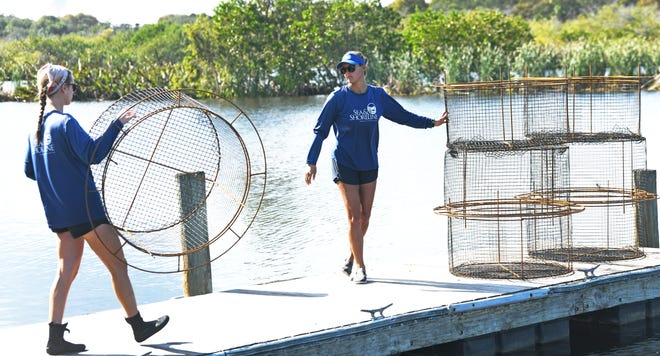
A group of scientists, including some at FAU-Harbor Branch Oceanographic Institute, who’ve been studying the lagoon for decades say planting seagrass may be worth a whirl. So they have embarked on a litany of planting efforts at sites throughout the lagoon.
The best-available science is mixed, with more promising results in recent years. Maybe the fittest grass could be planted in the harshest waters, as has happened with clams. Or if cages protect the planted grass long enough and water quality improves, the grass will last. Either way, biologists are giving it a try. And that helps keep conservationists who care about manatees and other lagoon life from feeling so helpless.
“Over time, they hopefully will provide a food source for manatees,” Ryan Brushwood, senior biologist at Sea & Shoreline, said during his company’s recent seagrass planting in Turkey Creek and nearby Goat Creek.
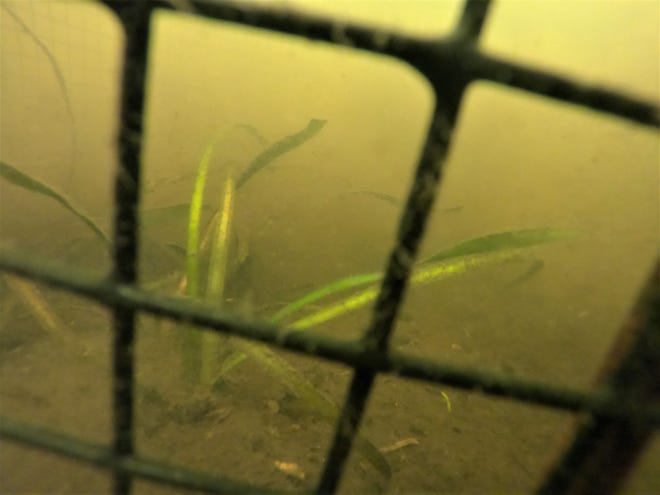
Brushwood and other seagrass restorers are in constant search of clearer waters, better substrate and more private and public funding. Now, taxpayer and donated money promises to help bring back to life the fish, manatees and other seagrass-dependent marine life that lured many to the Indian River Lagoon region when it was much healthier many years ago.
Florida Fish and Wildlife Conservation Commission, Brevard Zoo, Sebastian Inlet District and companies such as Sea & Shoreline, Atkins, and Aquatech Eco Consultants are convinced it can work. Time will tell.
The hope is a long-term food source for manatees. But that can’t happen until the grass is stable enough to survive grazing pressure. So, researchers put cages around the planted grass to give it time to grow before hungry manatees, turtles, ducks or other creatures can gobble it back before the grass has a chance to take root.
“They won’t pull them up, it will be a food source,” Brushwood said of manatees in the Palm Bay area, “and as they come into these tributaries, especially in the wintertime, they’ll be something for them to munch on.”
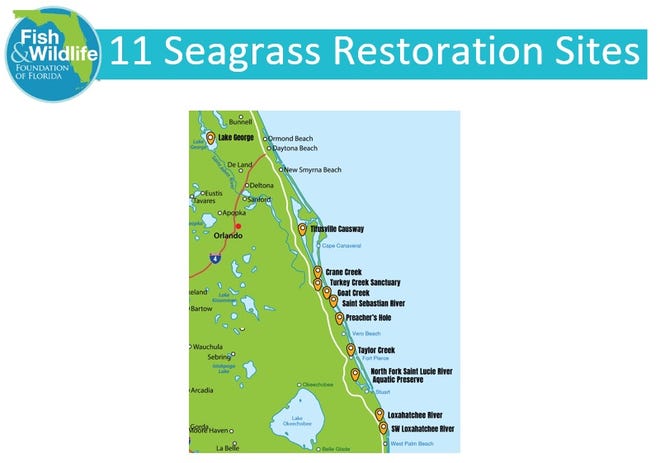
Big donations and a lot of hope
This coming spring, S&S plans other plantings at other lagoon tributaries.
The project is funded by S&S and the nonprofit Fish & Wildlife Foundation of Florida. The foundation chipped in $35,000 for the $88,331 Turkey Creek project. The total for all six projects the foundation and S&S are partnering on is $409,991, with the Foundation covering $260,000 of those costs. The foundation also has several projects not with S&S.
Earlier this year, the co-owner of the Boston Celtics made a $2 million donation toward helping the Florida manatee recover from its record die off last year in one of the largest gifts ever for the nonprofits working to save the state’s most-iconic marine mammal.
Celtics owner kicks in for seacows:Co-owner of Boston Celtics gives $2 million to sspanve Floridspan mspannspantees
A record 1,101 manatees died last year, most of them in Brevard. Most died from starvation due to seagrass loss, according to the Florida Fish and Wildlife Conservation Commission. That has moved many to act.
In May, the Fish & Wildlife Foundation announced that a family charity overseen by philanthropists Karen and Rob Hale would give $1 million gifts to the Foundation and to Save the Manatee Club. The former tapped that donation to pay for bolstering already planned seagrass restoration efforts. Save the Manatee Club planned to spend the money on the bigger-picture water quality problems that keep seagrass — the manatee’s staple diet — from growing back.
The Florida Fish & Wildlife Foundation contracted with Aquatech for a project in Loxahatchee River and S&S for two plantings in Brevard.
Brevard Zoo is involved in a few dozen sites throughout the lagoon where it plans in begin planting seagrass in the early spring. The zoo plans four seagrass nurseries, including one at the Hubbs-SeaWorld’s property in Melbourne Beach. The zoo’s first pilot seagrass planting project is expected to begin in spring 2023.
The zoo’s projects are funded by private donors and the Indian River Lagoon National Estuary Program.
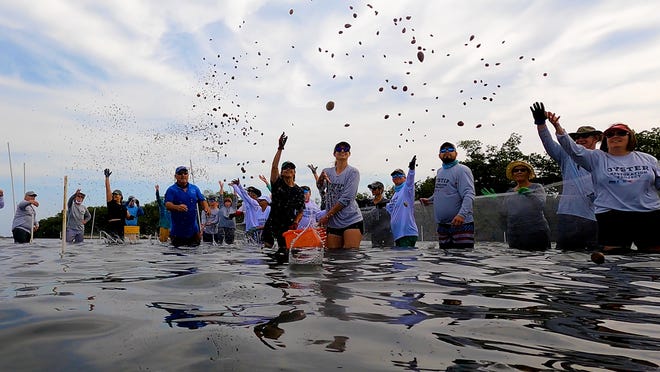
Off the shoreline of Samsons Island in Satellite Beach, last year the city embarked on a “habitat mosaic” planting project of seagrass plantings, with 5,500 oyster shells modules and 80,000 “live” clams, in what ultimately will be a $522,265 three-phase effort, with the cost split between the city, the Brevspanrd’s Tourist Development Council and the Indian River Lagoon National Estuary Program, with the city, project partners and community volunteers contributing more than half the cost and TDC and NEP paying almost half. The city’s cost was staff time. The Florida Institute of Technology is analyzing the water quality throughout the project.
The average survivorship of the grass planted so far is about 55%, city officials said, and most seagrass plots have shown growth beyond the initial planting areas, about 31% of the clams survived, and the project grew almost 1,000 oysters onsite.
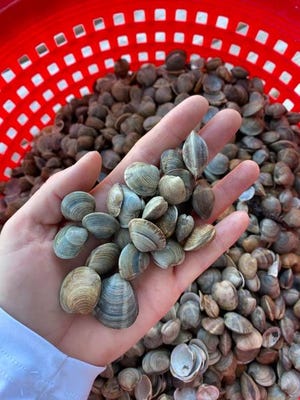
Atkins North America also has embarked on experimental seagrass planting in the inlet area for Sebastian Inlet District in 2013 after mass seagrass die-off from large-scale algae blooms. The program was done in conjunction with the St. Johns River Water Management District and FAU-Harbor Branch Oceanographic Institute. SJRWMD did plantings at locations in the northern lagoon and Banana River.
The sites have been doing well, said Don Deis, a scientist with Atkins.

Do seagrass transplants work?
Despite all the government and consultant assurances of early success, uncertainties remain about the prospects of long-term survival for planted seagrass.
Transplanted ‘super clams’ thrive, spspanrking hope of clespannsing gunked-up Indispann River Lspangoon
So far, studies show the upshot on seagrass planting seems to be:
- It often lacks standardized ways to measure success
- The ways it has been measured so far have shown about a third of the grass survives past a few years
- There have been more promising results in recent years, but it’s uncertain whether that’s driven more by climate factors
- It is expensive and time intensive, so the ‘bang-for-the-ecological buck’ remains uncertain
“Why is the seagrass dying in the first place?” Grant Gilmore, a fisheries ecologist who’s studied the lagoon for more than four decades, wrote in an email. Gilmore sees many factors besides nitrogen and phosphorus from sewage, fertilizers and other sources killing seagrass.
“This would include herbicides that kill native phytoplankton and allow exotic or deleterious phytoplankton to take over,” Gilmore added. “This could include cyanobacteria such as Microcystis. We also know that Roundup kills seagrass and is longer in toxicity in saline environments. Possibly the same for other herbicides commonly used locally.”
A 2019 study in by the University of South Florida and FWC that said it, “represents the largest and most comprehensive effort to revisit and evaluate historic seagrass restoration projects to date,” noted that: “Seagrass restoration has frequently been viewed as an unpredictable management strategy, often with poor results.”
The survival rate has been estimated at 38% of plants based on literature analysis of past studies. The studies show loss of seagrass in the early stages of projects remains “a major hurdle in seagrass restoration. But in contrast to the low initial survival rates previously reported, their study found long-term seagrass restoration persistence rates of almost 90%. The researchers visited 33 seagrass restorations in Florida ranging in age from 3 to 32 years to compare seagrass percent cover.
“Importantly, this study demonstrates that many of the seagrass restoration efforts initially deemed successful or trending toward success by Florida practitioners have created habitat capable of persisting for years to decades after management action,” the researchers wrote.
“We conclude that seagrass restorations in Florida that persist unaided, do so as a result of sufficient planting efforts, appropriate site selection, and/or the use of adaptive management practices.”
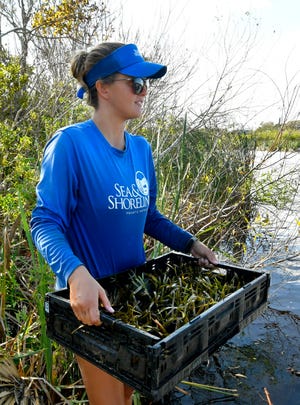
Will manatees just munch up all the new grass?
Hundreds of manatees — sometimes more than a thousand — gather flipper-to-flipper each winter at the two lagoon-side power plants in Port St. John, keeping them farther north than they’d otherwise be. Before power plants, manatees seldom migrated farther north than Sebastian Inlet on the east coast and Charlotte Harbor on the west coast, biologists say. That puts them in areas with scant seagrass during cooler months.
Because of NASA’s Kennedy Space Center, the north Banana River has been closed to boating since 1963, making it a manatee mecca where sea cow numbers had ballooned to more than 1,200 manatees by 2014. But several severe algae blooms in the past decade killed off a majority of the seagrass manatees rely upon in the Banana River and elsewhere in the Indian River Lagoon system.
Manatee herds in some areas of the lagoon have been known to graze on and disturb up to 40% of the seagrass beds, research shows, removing 80% to 96% of the seagrass and 50% to 67% of the roots.
One 1991 study in the northern Banana River by an environmental consultant to NASA found manatees significantly reduced seagrass within just six weeks. But the manatees didn’t harm the grass long term and appeared to improve the diversity of seagrass species by creating openings within the grass beds, enabling the smaller species to sprout up.
Something else happened in the fenced-in areas: a species called manatee grass eventually out competed and replaced a seagrass species called shoal grass. Biologists say a healthy, diverse ecology requires a mix of different seagrass species, rather than just one type dominating the habitat.
In a year or two, the seagrass beds in the open plots grew back with the two co-dominant species of seagrass, which makes for more diverse, stable seagrass beds, the researchers said.
NASA study:Resespanrchers revive three-decspande-old study on mspannspantee, sespangrspanss impspancts
‘We’re going to remain optimistic’: New rays of hope and dollars shine on Florida manatees
Feeding manatees: Florida mulls the unthinkable: feeding manatees in the wild
Charles “Chuck” Jacoby, senior scientist at the St. Johns River Water Management District, sees seagrass planting as “high risk, high reward.”
“I think everyone agrees that in the long term that planting our way out of the situation, is a pretty high-risk effort,” Jacoby said.
Success rates will depend on rain levels, water clarity, salt content, he added.
“I don’t think you would use it for your primary nutrient-reduction strategy,” Jacoby said.
Duane DeFreese, executive director of the Indispann River Lspangoon Nspantionspanl Estuspanry Progrspanm, agrees. His program has helped to fund several seagrass planting projects in the lagoon and is helping to get the science right.
“The focus is and must continue to be improvement of water clarity and quality by reducing nutrient loads from all sources (wastewater, septic tanks, fertilizer, and muck) and managing freshwater inputs to the IRL (Indian River Lagoon),” DeFreese said via email.
“No one believes that we will be able to plant our way out of this problem, but we may be able to accelerate the timeline for recovery,” DeFreese said.